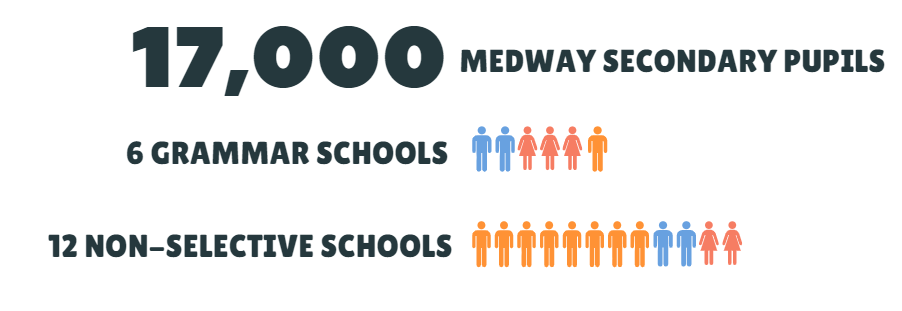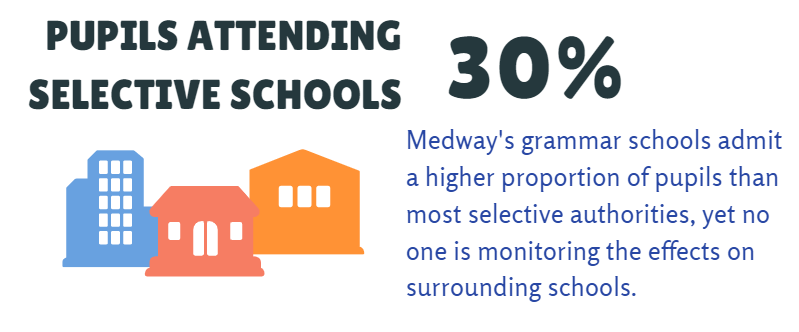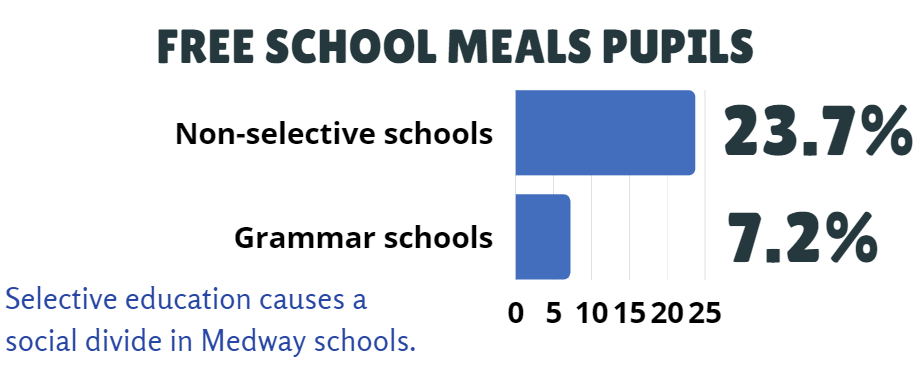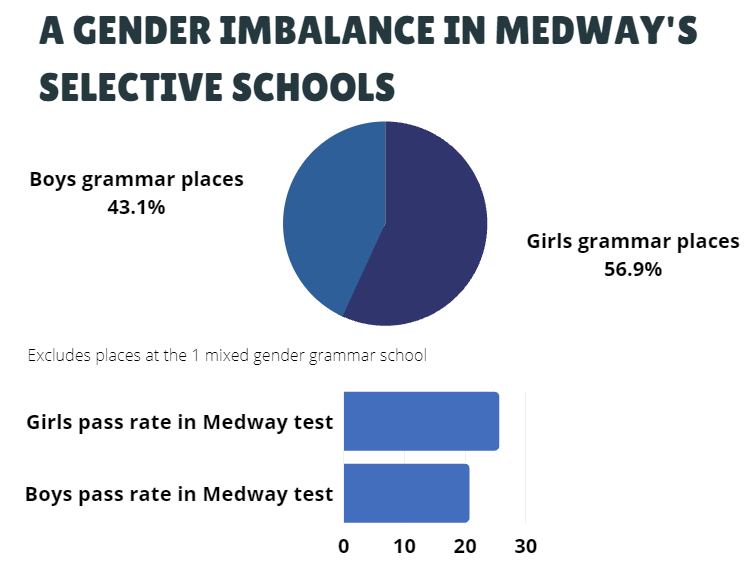 Selective education guide – Medway
Selective education guide – Medway
BACKGROUND
Medway has six grammar schools which educate a very high proportion of higher attaining students both from Medway and the surrounding area.
Check out our map of selective schools in England to find out more about these schools. The map includes the percentage of disadvantaged pupils, the percentage of pupils attending a grammar school who are likely to have come from a fee-paying ‘prep’ school, and the relative selectivity of every grammar school in Medway. View the map HERE.
Or, to read stories from parents and teachers experiencing selective education in Medway visit the 11+ Anonymous website HERE.
THE PROBLEMS
In every area where academic selection still exists there are some common problems. For example,
- Grammar schools admit fewer disadvantaged pupils than non-selective schools. Grammar schools are also more likely to admit pupils from more advantaged families.
- A significant number of pupils previously educated in fee-paying ‘prep’ schools take up grammar school places. In some Medway grammar schools more than 10% of pupils were previously educating in a private primary school.
- Tuition for the 11-plus ‘buys advantage’. Better-off families can afford private coaching while poorer families may feel compelled to pay for tuition they can ill afford.
- Sitting the 11-plus is stressful and can damage a child’s confidence.
- The 11-plus has been proven to lack accuracy because it takes place while children are still developing academically.
- Research shows the proportion of children with Special Educational Needs (SEN) attending grammar schools is small. For many children with additional learning needs such as dyslexia and attention deficit disorders, the 11-plus test is inaccessible. The same children often perform very well academically outside a test situation.
- Grammar schools change the pupil profile of other schools in the area. If a large number of higher attaining pupils attend grammar schools then surrounding schools find themselves with a pupil population which is skewed, with a disproportionate amount of moderate and lower attaining pupils, and pupils with additional learning needs This impacts on subject choice (fewer subjects available than at a grammar school) and teacher recruitment. Non-selective schools in areas with grammar schools cannot be ‘true’ comprehensives and tend to underperform compared to comprehensive schools.
- GCSE results in areas with grammar schools are on a par with, or worse than, areas that have only comprehensive schools. Research has shown that children who attend selective schools would achieve broadly the same results if they attended a non-selective school.
The percentage of pupils attending grammar schools in Medway
30% of Medway’s secondary school pupils attend its six grammar schools. This is a significant proportion of pupils which means the impact on the pupil population of surrounding schools is also significant.
The Department for Education classifies Medway as a ‘highly selective’ authority. Although the DfE acknowledges that selective areas such as Medway are offering a different type of education than other areas of England, the impact of a local authority educating its pupils in an alternative education system is never scrutinised. The lack of checks and reporting requirements means the full impact of a selective school system cannot be fully understood. There are many aspects of selection which remain shrouded in secrecy.
A social divide in Medway’s secondary schools
In common with all grammar schools, disadvantaged pupils are underrepresented in Medway grammar schools. As a result, the county’s non-selective schools educate a far greater proportion of pupils on free school meals.
Many academics argue that a selective education system risks creating the kind of divisions which go beyond the schools themselves and can affect the wider community more generally.
The 11-plus damages children’s confidence
Many children feel demotivated by a ‘fail’ in the 11-plus. We believe all children should start secondary school feeling positive about their academic ability. The success of non-selective schools in most areas of the country proves that there is no need to divide children by using an out of date and discredited test.
Pupils who live in Medway are less likely to pass the 11-plus
State educated primary pupils who live in Medway are less likely to pass the 11-plus than out of county and privately educated pupils.
The discrepancy may be explained by the fact that some private schools coach pupils for the 11-plus test and/or families who live in the more affluent areas surrounding Medway are more likely to be able to afford private tuition. Research shows that access to grammar schools is heavily influenced by a child’s socioeconomic status. Disadvantaged pupils living in selective areas, like Medway, stand only a 6% chance of attending a selective school.
The Medway test is biased – girls are more likely to pass than boys
The Medway test, with its emphasis on written English skills is said to favour girls and there are more grammar school places for girls in Medway. It would appear that Medway council, who set the test, are reluctant to have equal numbers of girls and boys in its grammar schools. This unusual arrangement has been in place for some years and is not explained by Medway Council.
More information
You can read more information about Medway’s grammar schools and the 11-plus, including test dates, by visiting the Medway Council website.
Want to end the 11-plus in Medway?
Join Comprehensive Future’s campaign to end the 11-plus.
To learn about the data sources for our interactive map and selective education guides click here. If you spot any errors in the data for any area, please let us know and we will correct it.






